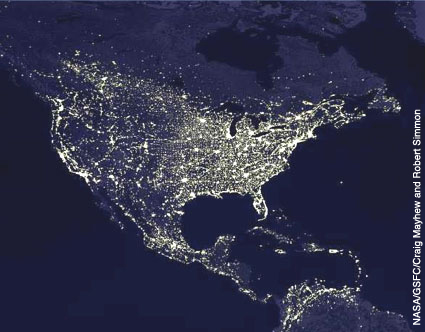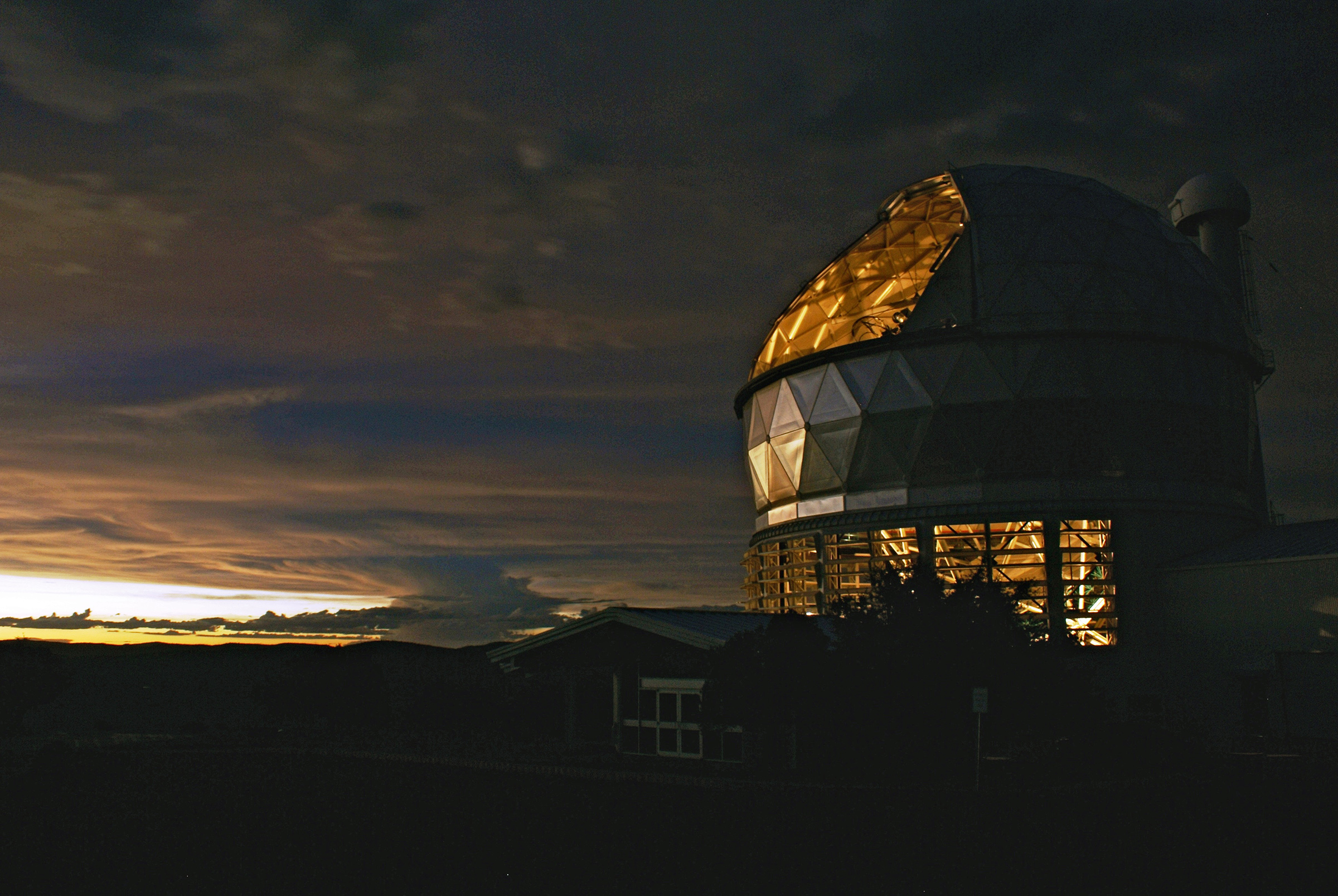PBPA gets behind an idea that is out of this world: the Dark Skies Initiative. Acting before drilling operations pose a serious problem in Reeves County and Jeff Davis County (and the Fort Davis area), oil companies get on board a plan to keep the skies dark above the McDonald Observatory.
By Bill Wren, McDonald Observatory
In April 2017, the Permian Basin Petroleum Association (PBPA) published its “Recommended Lighting Practices” for oilfield lighting. The Recommended Practices (RPs) were developed in partnership with the University of Texas McDonald Observatory, a world-class astronomical research facility located in the heart of the Davis Mountains near Fort Davis, and are formulated to help protect the dark night skies for the Observatory and improve visibility for nighttime activities in the oilfield. The RPs also include language to mitigate sky glow resulting from the flaring of excess natural gas.
Old Man McDonald’s Telescope
McDonald Observatory is a satellite campus of the University of Texas at Austin established atop Mt. Locke in the heart of the Davis Mountains in 1932. It was made possible by the bequest of William Johnson McDonald, a Paris, Texas, banker who passed away in 1926 and left the bulk of his estate, some $1 million, to the University’s Board of Regents to build what was the second-largest telescope in the world when dedicated in 1939. That telescope remains in constant use.
Today, the Observatory is home to the world’s third largest telescope, the Hobby-Eberly Telescope (HET), an instrument designed for cutting-edge astronomical research requiring the darkest skies to see the faintest, most distant objects in the universe. Fortunately, the remote location provides for skies as dark as can be found at any other major observatory.
The HET is nearing the end of a $40 million upgrade that will enable it to gather thousands of spectra per night in a survey of many types of objects, including a scattering of remote galaxies, in an attempt to understand Dark Energy. Some observations will involve the collection of only a few dozen photons, or particles of light, per hour, and require extremely dark skies.
The Observatory has acquired an All Sky Photometry system to monitor and measure changes in the brightness of the night sky. Since the first observations in 2015, the sky averages about 18 percent brighter than a naturally dark background sky. Nearly all of this brightening, however, occurs near the horizon in the direction of the Permian Basin.
The area of sky near the horizon is of little astronomical interest. Astronomers are looking up. For example, the field of study for the HET Dark Energy Experiment centers around 55 degrees above the horizon, well above any significant brightening from light pollution.
The concern is not over the current state of our skies, but rather what the future holds as oil and gas exploration and production increases near the Observatory. As the sky brightens, the exposure time required for observations increases and costs go up. Eventually, the sky could brighten to the point that faint objects of interest will disappear in the glow.
Dark Skies—Not Dark Ground
The PBPA’s lighting recommendations are targeted primarily at activities in the seven counties surrounding the Observatory: Jeff Davis, Brewster, Presidio, Pecos, Reeves, and Culberson. Each of these counties, and all of the cities within, have outdoor lighting ordinances designed to protect the night skies for ongoing research at the Observatory. There is little active enforcement of these ordinances, except in cities with code enforcement officers, and enforcement typically is prompted by a formal complaint filed by a citizen. The Observatory regards these ordinances as vehicles for education and awareness about the benefits of good lighting practices.
In the case of oilfield activities, for example, following the RPs for lighting will not only help protect the night sky, but also improve the nighttime working environment across the Permian Basin by reducing glare and increasing visibility.
President of the PBPA, Ben Shepperd, told the San Antonio Express News, “One thing we learned is those bright white lights are actually bad for your eyes.” He said proper lighting could improve safety around drilling sites, which involve lots of tools and heavy machinery.
The recommendations also encourage the use of internal combustion units, which would reduce the need for open flaring. Operators active in the region should easily adopt these recommendations because they don’t involve additional costs or major costs. “It’s just different equipment,” Shepperd said.
The PBPA plans to use the RPs as a vehicle to educate the industry on the benefits of good lighting practices as they apply to oil and gas activities.
The LED Revolution
Many operators and contractors are modernizing lighting systems to Light Emitting Diode (LED) technology because of its many benefits, which include dramatically less power consumption, as well as solid-state reliability, lighter weight, and longer lifetime. The LED presents an excellent opportunity to light the industry in a way that increases safety and preserves the night sky for the Observatory, provided the technology is implemented correctly.
Early generations of LEDs tend to emit “cool” blue-rich white light in an attempt mimic daylight with a color temperature around 6000K. The human eye, however, sees better at night with a “warmer” white light, closely mimicking that of an incandescent bulb with a color temperature around 3000K. The “cool,” blue-rich white light contributes more to glare and sky glow as it scatters more off particulate matter in the atmosphere.
When first introduced, the higher temperature “cool” LEDs were more cost efficient and cheaper to make. As the manufacturing process continues to improve, however, the lower temperature “warm” LEDs are becoming more efficient and more widely available. The PBPA recommends using LEDs with a color temperature of no more than 3500K, preferring 3000K.
Another characteristic of the LED is that, unlike a frosted bulb, it is a point-source of light. Exposing the eye to bright point-sources creates glare. Such glare can be debilitating, especially given the intensity of modern LEDs. The solution is to keep the light source from the line of sight and lower the color temperature. Fixtures should be designed and installed in such a way as to minimize direct exposure to the LED itself, and illuminate only the area of interest.
See for Yourself
Regardless of the light source, the PBPA’s recommended practices are simple and cost-effective to implement. First and foremost is to install light fixtures so that little to no light spills offsite or shines above the horizon. This may be as simple as attaching an aftermarket shield and/or adjusting existing floodlights so they aim down, ideally straight down, but no more than 20-degrees from vertical if wider coverage is needed.
Aiming lights down results in more light onsite and less glare in workers’ eyes. As fixtures are aimed up, away from vertical, the light shining skyward, and glare, increase.
Find a floodlight aimed to a high angle and adjust it to point downward. Do it at night, if practical, to see where the light falls. It’s often surprising how much this improves visibility by directing light onto the worksite and out of people’s eyes. “Seeing is believing.”
Making a Good Start
The benefits of improved lighting practices apply to both the exploration and production sides of the industry. There are many permanent facilities that can benefit from shielding, aiming fixtures down, and the use of “warmer” lights.
No one wants to flare natural gas. The internal combustion units recommended by the PBPA are a good stopgap measure for dark skies, but pipeline infrastructure to get the gas to market is a win-win solution for everyone. Apache Corporation has shut in many of their latest exploratory wells in the Alpine High play near the Davis Mountains to avoid flaring gas as they build gathering systems.
Lastly, a lot of commercial development comes with oil and gas development. The Observatory is actively working with local municipalities to ensure that new hotels, restaurants, and businesses of all types are informed of the existence of city lighting ordinances before they start to build in the community. The assumption is that everyone wants to be good neighbors, follow the law, and have better lighting. It’s much easier to use good lighting in the first place than to go back and clean up a mess already made.
For more information, visit the McDonald Observatory website at mcdonaldobservatory.org or go direct to this webpage: mcdonaldobservatory.org/darkskies.
Bill Wren of the McDonald Observatory in West Texas is considered the godfather of Texas’ Dark Skies Movement. He has been spreading the dark skies gospel ever since attending an International Dark-Sky Association conference in 1990 during his first days as special assistant to the superintendent of the world-renowned observatory. “I learned there is no conflict between having good lighting at night and dark skies,” Wren says. “We’re not anti-light. It’s real simple. If everyone would just keep their light on their own property, it would alleviate concerns about light pollution and light trespass.”











